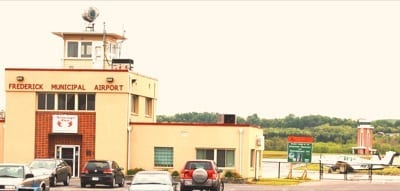May 1 was the day many in Frederick, Maryland, had long awaited — or dreaded, depending on your point of view. The home of the Aircraft Owners and Pilots Association (AOPA), defender of our freedoms to fly, was finally getting a control tower. Was it a day to celebrate or commiserate?
A control tower had been in the works for years. FDK had grown up along with its host city, which had blossomed as Washington, D.C.’s northernmost exurb. Air traffic skyrocketed with FDK’s location just outside Washington-area Class B and ADIZ airspace. Earlier, a widened and lengthened Runway 5-23 and ILS had started attracting jets. Old Runway 1-19 was closed to avoid conflicts, offer more taxi routes and expand hard surface parking.

In its uncontrolled heyday, FDK was a versatile symphony of self-coordination. Savvy pilots kept up a prodigious operational pace despite ILS straight-ins and glider club landings on the cross-runway grass area. The problem came on weekends: Seven in the pattern, some of them from out of town. Approaching FDK in the AOPA jet, one always cinched up his seat to face the complicated traffic picture ahead.
Another factor favoring a tower: Continual busts of P-40 around Camp David atop mountains not far north of the field. In the old days, irate Secret Service or military guys monitoring their special radar would call and ask Frederick Aviation to detain a violator. “There, he’s just landing now,” they’d say. Irascible Pat Patrick behind the counter would reply, “Oh really? We’ve got a full pattern here. Just tell me what color the plane is.” Click.
These days post-9/11, the air security stakes are higher. Along with P-40 to the north, the boundary of the Washington ADIZ is not far south. I’m sure closer supervision of area traffic is welcome to security interests. After all, the G-8 Summit will take place at Camp David later this month. Its TFR will probably leave a scant two miles for airport traffic on FDK’s north side.
Perhaps P-40 busts will be reduced. But most likely, traffic will slow — as usually happens when a tower replaces CTAF.
Should we long for “the good old days?” Don’t bother. Although Frederick Airport Manager Kevin Daugherty says traffic is down 20-30% from pre-recession levels, it will rebound. More important with the mix of jets and singles at Maryland’s second busiest airport, a tower can make everyone more comfortable. This certainly includes many a flight department whose insurers often mandate towered-field operations.
The gliders will still operate simultaneously on the cross-wind runway (12-30), just not on its adjacent grass anymore. Frederick Aviation is now Landmark Aviation, ready and waiting for more jets. The character of the field will again change — as it had before with runway reconfiguration, new hangars and more apron space. Nothing stays the same in aviation. The secret, as always, is to enjoy what you have while you have it.
The old FDK airport was great in its time. And now the airport moves ahead, enhancing its potential. That tall, modern control tower — in classic Maryland brick finish — symbolically joins the Frederick skyline of downtown towers and steeples, the old city’s fabled “clustered spires.” That new airport tower will serve many needs.
Story and photo © 2012 Drew Steketee
Drew Steketee was president of BE A PILOT, senior vp-communications for AOPA and executive director of the Partnership for Improved Air Travel. He also headed PR and media relations for Beech, GAMA and the Airport Operators Council International.
People who read this article also read articles on airparks, airshow, airshows, avgas, aviation fuel, aviation news, aircraft owner, avionics, buy a plane, FAA, fly-in, flying, general aviation, learn to fly, pilots, Light-Sport Aircraft, LSA, and Sport Pilot.

Never been there. However, can’t see how a tower can help much of anything except to slow everything down. Never seen a relatively small airport where a tower helped much. Just more jobs for beaurcrats and more regulation.
Nice one, Drew. Good observations about KFDK. I remember one storied photo mission for AOPA PILOT (before my time) when the team supposedly brushed P-40. Secret Service called Frederick Aviation and asked them to report who was landing (the voice on the phone said “the photographer has a beard….” Drew, you’ll recall who that was….). The person behind the FBO desk promptly told the crew to put the airplane away and get out of there. Everyone looked out for eveyone else.